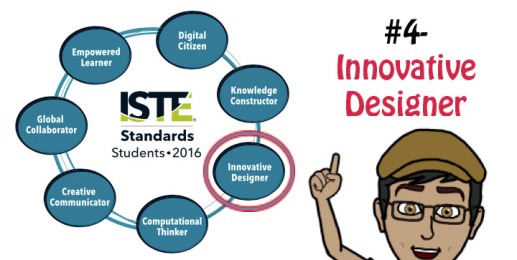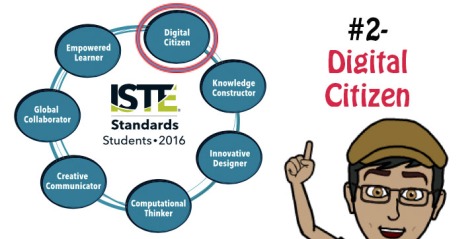
In this blog post, I discuss and provide tools and ideas for classroom implementation of the fourth 2016 ISTE Standard for Students, “Innovative Designer”. If you would like to read the blog posts for the first three standards, you can find them are:
For more background information about the new standards, read my blog post “Talking Tech: The New 2016 ISTE Standards for Students (1 of 8)”.
ISTE and its contributors have been publishing excellent documents that explain and support educators in the adoption and practice of these standards. Here are a few of them:
- I recommend following ISTE on Twitter. By checking their feed you can find lots of great articles about the different standards.
- ISTE Standards– This is a link to all ISTE Standards (for students, teachers, administrators, coaches, and computer science educators)
- The ISTE Standards Community– Check out this living and breathing online community for discussions, announcements, community blogs, and much more!
- ISTE Standards for Students- eBook– ($10)- This eBook contains explanations, examples, suggested skills for implementation in different levels, a comparison to the 2007 Standards, a suggested Scope and Sequence, and more!
Standard 4: Innovative Designer
Students use a variety of technologies within a design process to identify and solve problems by creating new, useful or imaginative solutions.
Former US President Barack Obama saw the need to emphasize ingenuity and design in US schools, and in the second term of his presidency he created the first White House Maker Faire (called “Nation of Makers”) in order to encourage educators and students to create and innovate. This is exactly what this standard is about, and the key to its successful implementation is the use of a design thinking process as a tool to designing creative solutions to complex existing problems. It is the process through which a problem is identified, an idea (or ideas) for a product/solution is suggested, planned, tested, and revised (again and again) until it becomes viable to be implemented and used.
(The stereotypical design thinking process includes the above five steps)
Let us examine some of the tools and resources that would allow us to guide our students not only in the process of making and innovating, but in instilling a new mindset and approach to problem solving:
What is Design Thinking?
It is important that educators, at any given school, work together to adopt a common process. Although the idea of the design thinking process is relatively consistent across different models, one must remember that it originates from a more professional organizational setting, not from schools. Here are a few resources that would help educators and students to understand what the design thinking process is, and choose a model that best fits their setting:
- Videos- What is Design Thinking?
- In this video, Daylight explains what Design Thinking is and how they followed the five steps to successfully get American children to get more exercise.
- John Spencer and A.J. Juliani designed a student-friendly process called LAUNCH (more information below). This video explains their innovative process and how it works.
- TEDx (13:44 minutes)- Five great rules for teaching Design Thinking that would allow educators to reach all students.
- A great video playlist to explain what Design Thinking is and how it is implemented in different schools. (and here is a TED search for great Design Thinking videos, blog posts, and more)
Design Thinking Toolkits and Tools:
- IDEO and Riverdale County School’s free Design Thinking Toolkit for Educators is an excellent comprehensive guide for using the process in the classroom. Check out the website, get the toolkit, and get to work!
- LAUNCH- Check out the website for some information about the student-friendly cycle, and find resources on how it is being used in classrooms. You can purchase the LAUNCH book or visit John Spencer’s or J. Juliani’s excellent blogs that focus on Design Thinking and innovation.
- Innovation Flowchart (more complex)- The Innovation Flowchart gives a detailed overview of the various stages in an innovation process, listing the activities, requirements and goals of each stage. A very useful planning tool to bring ideas to life.
Ideas for Design Thinking projects and activities:
- CityXProject– A project that uses 21st century skills, including emotional literacy, empathy, design thinking, creative problem solving, and social literacy using hands-on engagement with 3D printing (optional) and modeling technologies. You can get the toolkit to run your own workshop with your students.
- KidsThinkDesign– A collaborative effort of professional designers and creative college students, this great website was designed for students, teachers and parents to learn about professions that deal with design (graphic design, fashion design, architecture, and more), and to practice some of the design thinking skills through a variety of projects, collaboration, meeting professionals, and more.
- The Institute of Design at Stanford has a K-12 Wiki for design thinking projects and challenges, and has lots of resources to teach and practice design thinking.
The underline message of this standard is that students recognize the importance of the process of coming up with an idea and repeatedly refining it, until it becomes high quality. Whatever project your students engage in, they must go through the important stages in the design process, so that the product they create is well-thought-through, and is the best version of what they are capable of making.
Additional tools and resources for student-makers:
- TinkerCad– A simple browser-based 3D design and modeling tool. Users can come up with any idea and quickly design, print and cut it. There are basic tutorial lessons, and advanced designers can find lessons on how to create artistic objects of increasing complexity by tinkering with existing designs, as well as to work collaboratively to create new designs.
- Create How-To Guides are a great way for students to show their understanding and to ensure they include the correct and chronological steps when designing a product or explaining procedures. SnapGuide and Instructables are two great places for students to learn how to write instructions in an organized and inviting way, and to join large communities of makers and designers.
- iBooks Author (iOS; Free)- This Apple-made authoring program allows users to create beautifully designed interactive books, manuals, etc., and publish them to the Apple iBooks Store (or export as PDF)
- App Making- Tools for students to test, develop, and publish their own apps:
- MIT’s AppInventor– Initially designed to introduce educators and students to coding, this relatively simple (MS and higher?) is a block-based programming for creating apps for Android OS. You build your app on a laptop/desktop (Apple works too), and test it on your Android phone.
- Thunkable– A business idea that rose out of AppInventor, Thunkable uses similar but simpler drag-and-drop functionality. It is extremely simple and intuitive, and does not require any coding skills to create mobile apps.
- Swift Playgrounds– This is a simple iPad app which would allow youngsters to learn the skills to create a real iOS app.
- CommonSense has a good list of resources (with reviews) for different apps and programs to help students code on any platform.
- Guest Speakers- There are many great professionals you could invite to your classroom to share and discuss how the design thinking process applies to their work- how they came up with ideas, how viable these ideas were, how they changed and morphed into the final product, etc. If you would like to put a touch of tech to your guest speakers, you can always use Skype in The Classroom to find guest speakers around the world who are willing to share their knowledge and experiences with students.
*** Looking for even more resources?
- Here is InformED’s great list of 45 design thinking resources for educators.
- The online site of the book Invent to Learn: Making, Tinkering and Engineering in the Classroom has some great resources– from starting a Maker’s Lab to how to use different materials, related organizations, cool projects and much much more!
- You can find many great examples for projects and other resources on Pinterest.
- The hard working folks at CommonSense have come up with a list of design thinking tools- from ideas to projects to apps- they got you covered!
Students as Innovative Designers. I hope this blog entry provides you with useful resources to use in your classroom or at home. As always, if you have any other ideas for good resources, any corrections for what I wrote, etc. please leave a comment below.
Next one up, ISTE 2016 Standard for Students #5, Computational Thinker!





No comments:
Post a Comment